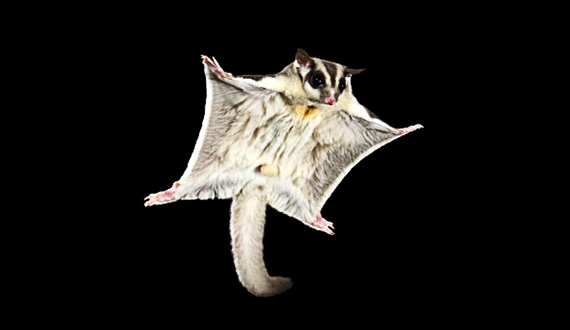
Photo: Sugar Glider gliding through the night sky
The sugar glider is a small, arboreal marsupial possum. It gets its name because it loves eating the sugary sap from plants and glides through the air from tree to tree. The sugar glider uses a furry membrane of skin called a patagium, which it spreads out and flies through the air like a tiny paraglider. Sugar gliders are popular as pets because of their cute appearance, social nature, and playful personalities.
A sugar glider has a lifespan of 5-9 years in the wild. In captivity, a sugar glider can live up to 12 years. The sugar glider's scientific name is Petaurus breviceps.
Sugar Glider Description What does a Sugar Glider Look Like?
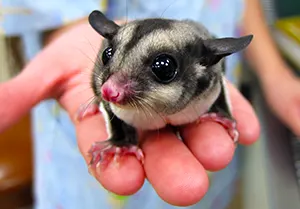
Photo: The sugar glider is tiny
The sugar glider has soft thick silver-grey fur on its upper body. The fur on the underside of its body is cream in colour. It is about 200-300mm in length, including its tail. The sugar glider has large bulging eyes with excellent night vision that enables it the avoid obstacles when gliding at night. The male is larger than the female and weighs approximately 140 gm. The female weighs about 110gms. You can tell a male from a female by the bald scent spot on the male's head.
Can Sugar Gliders Actually Fly?
Strictly speaking, sugar gliders cannot fly—they glide. To fly means to move through the air with wings. To glide means to descend gradually from a higher point to a lower point in controlled flight. A sugar glider is an impressive glider. It can travel over 45 meters (150 feet) in a glide.
The sugar glider has a very thin skin membrane, called a patagium, attached from its wrists to each ankle (like a flying squirrel). It spreads this membrane out and uses it like a paraglider. It adjusts the angle and curvature of the membrane using its limbs to guide it through its flight. It can glide up to 50 meters from tree to tree. The sugar glider uses this mode of transportation to forage for food and to evade predators.
The sugar glider makes a noise that sounds like a squeaky toy being pressed very rapidly. ( listen to it here) when it is frightened, threatened or stressed. It yaps or barks like a tiny dog to communicate with other gliders. They also hiss and sneeze on their hands to moisten them with saliva while grooming themselves.
Sugar gliders are very social and frequently nest together in groups of up to 6 animals, but they are solitary hunters. They are playful but will fiercely attack any intruder.
Sugar Glider Habitat Where Do Sugar Gliders Live?
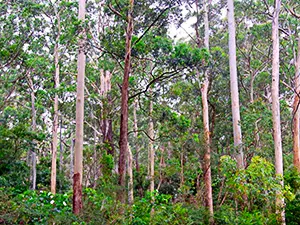
Photo: Eucalyptus and Acacia tree forest
Sugar gliders live in Eucalyptus and Acacia trees in northern, eastern and southern parts of Australia. Small pockets of these animals are also found in parts of Western Australia. They also live in Papua New Guinea and Indonesia.
Sugar gliders live in the tree tops and rarely come down to the ground. They make their nest out of leaves in a tree hollow. Between six to twelve gliders may share this nest. The availability of tree hollows for nesting is vital in determining the population of sugar gliders in a particular area.
Sugar Glider Diet What does a Sugar Glider Eat?
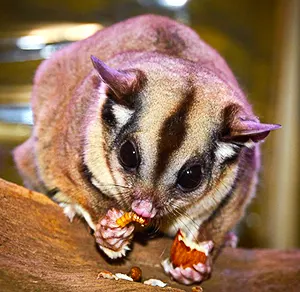
Photo: Sugar glider feeding
Sugar gliders eat insects, small lizards and birds. They also eat honeydew, pollen, manna and tree sap. A sugar glider eats up to 10% of its body weight each day.
In summer, when insects are plentiful, the sugar glider is primarily an insectivore. It may also eat small lizards and birds. When insects are less plentiful, it feeds on honeydew, pollen, manna and tree sap which it extracts by biting the smaller branches of gum trees to make the plant's sap ooze. The sugar glider forages for food at night and requires about 25% of its diet to be protein-based.
Sugar Glider Reproduction & Life Cycle Sugar Glider Babies
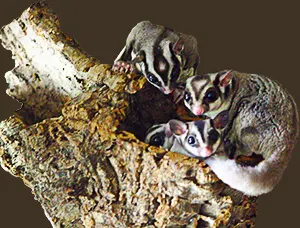
Photo: Sugar gliders and nest
Sugar glider males reach sexual maturity at about 12 months, and females between 8-15 months. Breeding usually takes place during winter and spring. Females give birth to two young about 16 days after conception. As with all marsupials, these underdeveloped babies crawl from their mother's birth canal into her pouch and attach themselves to a nipple there. The young spend about 70 days in their mother's pouch before being left in the nest for another 50 or so days. The young will then join their mother to forage for food until they are fully independent by the time they reach about 7-10 months.
The sugar glider's reproductive anatomy is very similar to other marsupials. Female sugar gliders have a pouch in which its carries its young. Males don't have a pouch or nipples. Like most marsupials, however, the male sugar gilder has a two-pronged penis (bifurcated penis). The end of the penis is split into two prongs.
Sugar Gliders as Pets Can You Keep Sugar Gliders as Pets
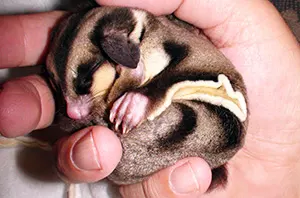
Photo: Sugar glider snuggled in hand
Sugar gliders are popular pets because of their cute appearance, social nature, and playful personalities. They love to engage in activities such as jumping, climbing, and playing. However, they require a lot of care and attention to thrive in captivity. They are social animals and should not be kept as a single pet.
Pet sugar gliders can be fed unseasoned (i.e. no spices or herbs etc.), cooked lean meat and poultry for their protein requirements. Other foods that should be used sparingly include cat food, hard-boiled eggs, yoghurt, and cheese. Live insects are a good treat. The rest of its diet should consist of fresh fruit such as apples, bananas, grapes, avocados, cantaloupe, carrots, sweet corn, grapefruit, mangoes, oranges, peaches, pears, etc. Do not feed your sugar glider sugar food intended for humans such as sugar, candy and chocolate. Make sure it has adequate fresh drinking water. They also need a large enclosure with plenty of climbing and hiding spaces.
In Australia, sugar gliders can be kept as pets in Victoria, South Australia, and the Northern Territory. It is illegal to do so in all other states of Australia. Sugar gliders can be kept as pets in most states of the US except California, Alaska, and Hawaii.
Sugar Glider Threats and Predators What Kills Sugar Gliders
The major environmental threat to this animal is habitat fragmentation with the clearing of forests by humans. Predators include kookaburras, owls, goannas, snakes, quolls and feral cats. Humans also steal baby sugar gliders from their nests and raise them as pets or sell them on the illegal black market.
Sugar Glider Conservation Status Are Sugar Gliders Endangered?
The sugar glider is not considered to be an endangered or threatened species. This is because they are common throughout their habitat. The IUCN Red List classifies their endangered status as being of "Least Concern". As with most wild animals, habitat loss is the greatest threat they face today.
Other types of Gliders Other Types of Possums that Glide
There are several other gliding possums in Australia.
Squirrel Glider - Is about twice as large as the sugar glider and very similar in appearance, habit, and behaviour.
Yellow-bellied Glider - Is about the size of a small rabbit and lives in eastern Australia. It can glide up to 150 meters.
Mahogany Glider - Is similar to the sugar glider and squirrel glider. It lives in a very small area of Queensland and is considered 'threatened'.
25 Sugar Glider Facts
- The sugar glider animal is a small gliding marsupial possum.
- It has a thin membrane attached to its wrists and ankles that it unfolds and para-glides from tree to tree.
- The sugar glider cannot fly; it can only glider.
- It lives in the tree tops of Eucalyptus and Acacia trees in northern, eastern and southern parts of Australia.
- It rarely comes down to the ground.
- It has large bulging eyes with excellent night vision because it feeds at night.
- It can glide up to 50 meters in the dark.
- The sugar glider weighs 110- 140gm.
- You can tell a male from a female by the bald scent spot on the male's head.
- It is about 200-300mm from nose to tail.
- It will easily fit in the palm of your hand.
- It is similar in appearance to a flying squirrel, but they are in no way related.
- The sugar glider has four-fingered hands and feet with opposable thumbs with sharp hooked claws for grasping onto its landing site.
- Its feet are so dexterous that they are used as an extra pair of hands.
- Sugar gliders eat insects, small lizards and birds.
- They also eat honeydew, pollen, manna and tree sap.
- It eats up to 10% of its body weight each day.
- They forage at night.
- Sugar gliders frequently nest together in small groups.
- While they are social and playful animals, they will fiercely attack any outsider.
- Sugar gliders use urine, saliva, and scent produced from their foreheads and chests to communicate with other gliders.
- Sugar gliders are popular as exotic pets.
- The major threat to sugar gliders is habitat destruction.
- They are not endangered.
- Sugar gliders live for about 5 years.
All Rights Reserved. (Last Updated: Apr 05, 2024)